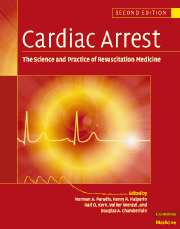Book contents
- Frontmatter
- Contents
- List of contributors
- Foreword
- Preface
- Part I Introduction
- Part II Basic science
- 3 Global cellular ischemia/reperfusion during cardiac arrest: critical stress responses and the postresuscitation syndrome
- 4 Genetics, genomics and proteomics in sudden cardiac death
- 5 Intracellular signaling during myocardial ischemia
- 6 Electrophysiology of ventricular fibrillation and defibrillation
- 7 The neuroendocrine response to global ischemia and reperfusion
- 8 Inflammatory and Immunologic responses to ischemia and reperfusion
- 9 Methodology of laboratory resuscitation research
- 10 The methodology of clinical resuscitation research
- 11 The special problem of consent for resuscitation research
- Part III The pathophysiology of global ischemia and reperfusion
- Part IV Therapy of sudden death
- Part V Postresuscitation disease and its care
- Part VI Special resuscitation circumstances
- Part VII Special issues in resuscitation
- Index
9 - Methodology of laboratory resuscitation research
from Part II - Basic science
Published online by Cambridge University Press: 06 January 2010
- Frontmatter
- Contents
- List of contributors
- Foreword
- Preface
- Part I Introduction
- Part II Basic science
- 3 Global cellular ischemia/reperfusion during cardiac arrest: critical stress responses and the postresuscitation syndrome
- 4 Genetics, genomics and proteomics in sudden cardiac death
- 5 Intracellular signaling during myocardial ischemia
- 6 Electrophysiology of ventricular fibrillation and defibrillation
- 7 The neuroendocrine response to global ischemia and reperfusion
- 8 Inflammatory and Immunologic responses to ischemia and reperfusion
- 9 Methodology of laboratory resuscitation research
- 10 The methodology of clinical resuscitation research
- 11 The special problem of consent for resuscitation research
- Part III The pathophysiology of global ischemia and reperfusion
- Part IV Therapy of sudden death
- Part V Postresuscitation disease and its care
- Part VI Special resuscitation circumstances
- Part VII Special issues in resuscitation
- Index
Summary
Up to 1000 cardiac arrests occur every day in the United States alone. The ultimate goal of cardiopulmonary resuscitation (CPR) research is to find ways of improving the survival and post-resuscitation quality of life of the cardiac arrest victim. New CPR techniques may improve survival by various mechanisms, but development of new techniques must be based on a comprehensive understanding of the process of CPR to ensure that the results have a sound basis. Many CPR studies are devoted to understanding the physiologic mechanisms taking place in the patient during CPR and the relationship among the physiologic mechanisms, the technique of resuscitation, and the actions performed by the rescuer.
The sequence of major events during cardiac arrest is shown in Fig. 9.1. Both the actions by the rescuer and the underlying physiology play important roles in the eventual outcome of the resuscitation effort. The patient's status during each intervention can be characterized by hemodynamic, neurologic, biochemical, electrophysiologic, and mechanical properties. Some of these properties,such as blood pressure or arterial blood gases, can be measured (quantified) under experimental and clinical conditions. Often, clinicians or researchers utilize qualitative properties, such as the size of the pupils or the pulse pressure, that are more easily evaluated but are less likely to provide accurate information. It is unfortunate that many important properties that directly influence the outcome, such as the force of compression and sternal displacement, often are not measured at all, even in animal studies. Measurements during CPR studies are difficult, especially in humans. Even in animal studies, blood flow, pleural pressure, compression force, and other physiologic determinants of flow are difficult to measure.
- Type
- Chapter
- Information
- Cardiac ArrestThe Science and Practice of Resuscitation Medicine, pp. 179 - 205Publisher: Cambridge University PressPrint publication year: 2007



